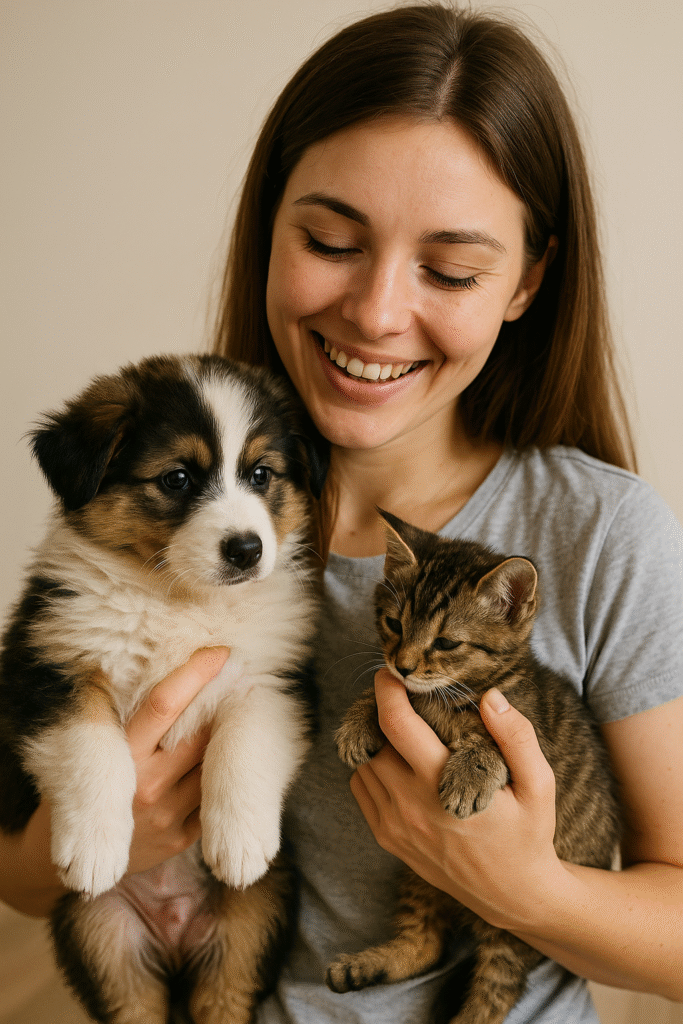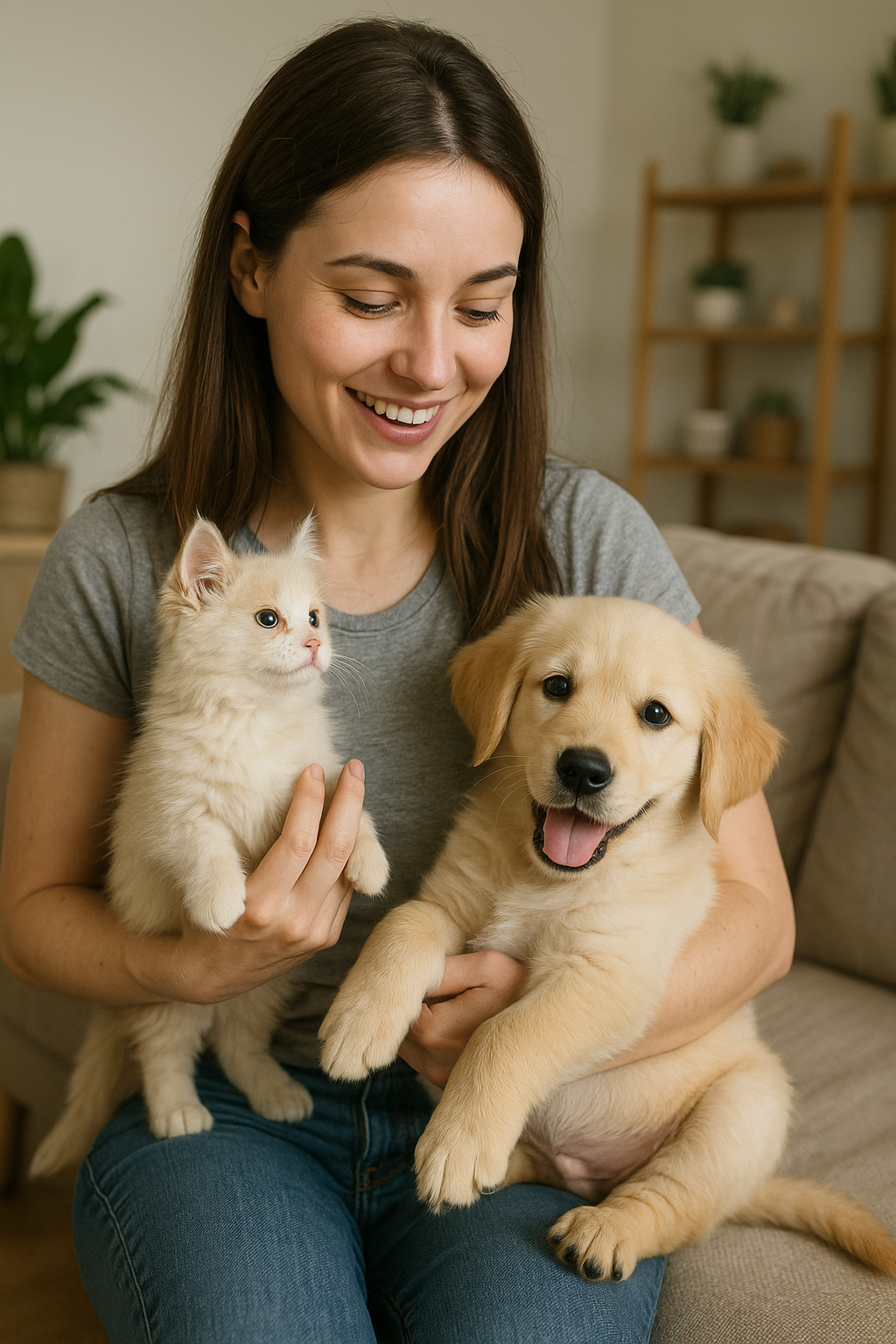Congratulations, new pet parents! That tiny ball of fluff curled up in your lap or exploring your shoelaces has officially stolen your heart. But let’s be real – between the sleepless nights, the mysterious puddles, and the sharp little teeth (or claws!), those first few weeks can feel less like a dream and more like a delightful, chaotic whirlwind. Take a deep breath. You’ve got this! This step-by-step, week-by-week survival guide is your roadmap to navigating the first 30 days with your new puppy or kitten, transforming panic into confidence and chaos into cherished memories.

The First 48 Hours: Landing Pad & First Impressions
- Goal: Safety, Security, and Scent Introduction.
- Your Home: Before they arrive, puppy-proof or kitten-proof ruthlessly! Electrical cords, toxic plants (lilies are lethal to cats!), small choking hazards, cleaning chemicals – get down on their level and see the dangers. Designate a quiet “safe zone” (crate for pup, small room for kitty) with bedding, water, and their carrier left open. This is their sanctuary.
- The Arrival: Keep it calm! Avoid overwhelming them with too many visitors or loud noises. Let them explore their safe zone at their own pace. Sit quietly on the floor, let them come to you. Offer gentle pets if they seem receptive, but don’t force interaction. For Kittens: Show them the litter box location immediately after arrival and gently place them in it. For Puppies: Take them directly to your chosen potty spot outside immediately after arrival and after every nap/meal/play session. Praise wildly for success!
- Food & Water: Stick to the food they were eating at the breeder/shelter initially to avoid tummy upset. Have fresh water available always. Feed scheduled meals (consult your vet on portions) in their quiet space.
- Sleep (Ha!): Expect disruption. Puppies need to potty every 2-3 hours, even at night. Kittens are often nocturnal. Prepare for interrupted sleep. Use a crate for your puppy (it’s a safe den, not punishment!). A cozy bed in a quiet corner works for kittens. A snuggle toy with a heartbeat simulator or a warm (not hot) water bottle wrapped in a towel can mimic littermates.

Week 1: Settling In & Starting Foundations
- Goal: Establish routines (Potty, Food, Sleep), Begin Socialization (Safely), Vet Visit #1.
- Routine is King (or Queen!):
- Potty Training (Puppy): Take them out CONSTANTLY! Immediately upon waking, after eating/drinking, after playing, and every 30-60 minutes otherwise. Use a consistent phrase (“Go potty!”). Praise like they just won the lottery when they go outside. Clean indoor accidents with enzymatic cleaner (NEVER ammonia-based). Litter Training (Kitten): Most kittens instinctively use a box. Keep it spotlessly clean (scoop 1-2x daily). Show them the location if they seem confused. Use unscented, clumping litter initially. Have one box per cat + one extra.
- Feeding: Stick to scheduled meals (usually 3-4x/day for young pups/kittens). Avoid free-feeding. Pick up bowls after 15-20 minutes. This helps with potty training and prevents pickiness.
- Sleep: Enforce nap times! Overtired puppies and kittens are bitey nightmares. Encourage naps in their crate/safe space. Aim for 18-20 hours of sleep for young ones!
- Socialization & Handling (Crucial!):
- Puppy: Introduce them gently to new sights, sounds, and surfaces in your home/yard first. Let them observe the world from a safe distance. Invite calm, healthy, vaccinated friends/family over briefly. Handle paws, ears, mouth gently daily. Make it positive with treats! Avoid public places like dog parks until fully vaccinated.
- Kitten: Introduce them gently to household sounds (TV, vacuum from another room). Handle them frequently – pick them up, touch paws, gently open mouth. Get them used to being gently restrained. Introduce calm family members/pets slowly and supervised.
- The First Vet Visit (Usually within first 72 hours):
- Essential! Bring any records from the breeder/shelter. Discuss:
- Vaccination schedule (Core vaccines: DHPP for pups, FVRCP for kittens; Rabies timing).
- Parasite prevention (fleas, ticks, heartworm for pups; fleas/ticks/intestinal worms for both).
- Deworming (common in puppies/kittens).
- Microchipping (Highly recommended!).
- Diet recommendations.
- Spay/Neuter timeline.
- Ask Questions! No question is too small. Find an AAHA-Accredited Vet (US) or RCVS Accredited Vet (UK)
- Essential! Bring any records from the breeder/shelter. Discuss:
- Biting & Scratching Management:
- Puppy Biting: Redirect immediately to a chew toy. Yelp “OUCH!” in a high-pitched voice if they bite skin hard and withdraw attention briefly (stand up, turn away). Consistency is key! Provide LOTS of appropriate chew toys (frozen washcloths, Kongs).
- Kitten Scratching/Biting: Redirect to a kicker toy or wand toy. Never use hands/feet as toys! Provide sturdy scratching posts/pads near where they sleep and play. Use catnip to attract them. If they bite/scratch during play, say “OUCH!”, stop play immediately, and walk away. Trim claws regularly (get vet to show you how!).

Week 2: Exploration, Play & Early Training
- Goal: Expand safe exploration, Structured Play, Introduce Basic Commands, Continue Socialization.
- Expanding Territory (Supervised!): Gradually allow access to more puppy/kitten-proofed areas of your home under watchful eyes. Use baby gates to block off unsafe zones.
- The Power of Play:
- Puppy: Short, frequent play sessions (5-10 mins). Use toys to teach “drop it” and “take it.” Tug is great if played with rules (you control start/stop). Fetch is tiring! Avoid overly rambunctious play before naps.
- Kitten: Engage their hunt-drive! Use wand toys, laser pointers (always end with a physical toy they can “catch”). Provide solo toys (balls, crinkle toys, small stuffed animals). Rotate toys to keep interest. Never leave string/ribbon toys unsupervised.
- Early Training:
- Puppy: Start simple! Focus on Name Recognition (say name, treat when they look), “Sit” (lure with a treat over their head), Recall (“Come!” – make it super fun and rewarding close by). Keep sessions VERY short (1-2 mins) and positive! Use high-value treats (tiny pieces of chicken, cheese).
- Kitten: Yes, kittens can learn! Clicker training works well. Target training (touch nose to your finger/stick) is a great foundation. Teach “come” using their name and treats. Keep it fun and brief.
- Continued Socialization: Introduce slightly more novel experiences based on their confidence. Short, positive car rides (in a carrier/crate). Meet one calm, vaccinated dog (for puppies) or calm person (for both). Always prioritize their comfort – don’t force interactions.
Week 3: Teething Troubles & Routine Refinement
- Goal: Manage Teething/Crate Training, Housetraining Progress, Vet Visit #2 (Often), Enrichment.
- Teething (Puppy Focus, ~12-16 weeks): Those needle teeth are being replaced. Expect increased chewing, drooling, maybe mild discomfort.
- DO: Provide an arsenal of safe, cold chews (frozen Kongs stuffed with wet food, frozen washcloths, puppy teething rings chilled in the fridge). Redirect chewing constantly. Supervise closely!
- DON’T: Give old shoes/socks (confuses what’s okay to chew), use ice cubes (can crack teeth), punish chewing – redirect instead.
- Crate Training (Puppy): If not already, make the crate a happy place! Feed meals inside, toss treats in, use calming pheromone spray. Start with very short durations while you’re home, gradually increasing. Never use the crate for punishment. Humane Society Crate Training Guide
- Housetraining/Litter Box: Accidents might still happen! Stay consistent and patient. If puppy accidents increase, backtrack – go out more frequently. If kitten avoids the box, ensure it’s clean, accessible, and in a quiet location. Try a different litter type if avoidance persists (consult vet to rule out UTI).
- Potential Vet Visit #2: Often for second round of vaccines/deworming. Discuss teething, behavior, and any concerns.
- Mental Enrichment is Crucial:
- Puppy: Food puzzles, snuffle mats, hiding treats for them to find, short training sessions, supervised exploration in the yard.
- Kitten: Puzzle feeders, cardboard boxes, paper bags (remove handles!), cat trees for climbing, window perches for bird-watching, hiding treats. Rotate toys!
Week 4: Building Bonds, Confidence & Looking Ahead
- Goal: Strengthen Your Bond, Increase Confidence, Prepare for Future Adventures, Reflect.
- Quality Time: Spend calm, connected time. For puppies, gentle grooming sessions, quiet cuddles. For kittens, gentle petting while they purr, quiet play with a feather wand. Learn their body language – what do relaxed ears, a slow blink, a loose tail wag mean?
- Confidence Building:
- Puppy: Introduce slightly more challenging (but safe) experiences – walking on different surfaces (grass, gravel, tile), meeting one new calm person, hearing new sounds at low volume. Always pair with treats and praise. Start very short leash walks in your yard/safe area if vet clears it.
- Kitten: Introduce cat tunnels, taller climbing structures, new interactive toys. Play “find the treat” games. Gently expose them to carrier (leave it out with treats inside).
- Looking Ahead:
- Next Vet Visit: Mark your calendar for the next vaccine booster (usually around 12-16 weeks) and discuss spay/neuter.
- Ongoing Training: Start thinking about puppy kindergarten (after vaccinations) or continuing clicker training with your kitten.
- Adolescence: Yes, it’s coming! Puppies around 6-18 months, kittens around 6-18 months too. Research what to expect (testing boundaries, energy surges!).
- Reflect & Celebrate: Look back at Week 1 photos! See how much they’ve grown and learned? See how much YOU’VE learned? Celebrate surviving the first month! You’ve laid an incredible foundation.
Essential New Pet Parents Toolkit: Must-Have Supplies
- Both:
- Quality Age-Appropriate Food & Bowls (Stainless steel or ceramic)
- Fresh Water Source (Fountain can encourage drinking)
- Secure Carrier (Hard-sided for travel, soft-sided for vet visits optional)
- Comfortable Bedding (Machine washable!)
- Collar with ID Tag (Phone number!) AND Microchip (Registered!)
- Basic Grooming Supplies (Brush, pet-safe shampoo, nail clippers/grinder)
- Enzymatic Cleaner (For accidents)
- Variety of Safe Toys (Chew, puzzle, interactive)
- First Aid Kit (Pet-specific)
- Vet Contact Info & Emergency Vet Location
- Puppy Specific:
- Leash (4-6 ft flat leash)
- Harness (For walks, better than collar-only)
- Crate (Appropriate size)
- Puppy Pads (Optional, can sometimes confuse outdoor training)
- Poop Bags (Lots!)
- Training Treats (Small, soft, high-value)
- Kitten Specific:
- Litter Box (Open tray initially is often best)
- Litter (Unscented clumping recommended)
- Litter Scoop
- Scratching Posts/Pads (Multiple, sturdy, different textures/sizes)
- Kitten-Specific Toys (Wands, kickers, small balls)
The #1 Tip for New Pet Parents: PATIENCE & CONSISTENCY
You will make mistakes. They will have accidents. There will be moments of frustration. That’s completely normal! What matters most is your patience and your consistency. Respond calmly to mishaps. Stick to the routines you establish. Use positive reinforcement (treats, praise, play) generously. The bond you’re building now through these sometimes-chaotic early days is the foundation for a lifetime of love and companionship. You’re not just surviving; you’re learning each other’s language and building an incredible friendship.
Welcome to the wild, wonderful, occasionally messy, and utterly rewarding world of being new pet parents! You’ve conquered the first 30 days – now go enjoy the journey.
Disclaimer: The information provided in this blog post is for general informational and educational purposes only. It is not intended as a substitute for professional veterinary advice, diagnosis, or treatment. Always seek the advice of your veterinarian or other qualified animal health provider with any questions you may have regarding your pet’s health, behavior, or specific needs. Never disregard professional veterinary advice or delay seeking it because of something you have read in this guide. While we strive to provide accurate and up-to-date information, pet care recommendations and best practices can evolve. All images used in this article are royalty‑free or licensed for commercial use and are provided here for illustrative purposes.
